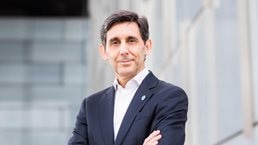This is the latest installment of Winning through Turns, a new McKinsey series of interviews with leaders in technology, media, and telecommunications. The first installment, featuring an in-depth conversation with José María Álvarez-Pallete López, chairman and CEO of Telefónica S.A. and board chairman of the GSMA, can be found here.
As the director general of the GSMA, Mats Granyrd knows firsthand the power of what the mobile communications sector can achieve when its many participants work together toward a common goal. The organization itself was founded back in 1987 to help support the adoption of what would become the most widespread global mobile network standard, GSM. Granryd believes the same degree of collaboration is just as critical now for the industry to succeed in the rapidly evolving telecom landscape. He outlined the importance of such a “federated solution” in a recent discussion with Tarek Elmasry, a senior partner and cohead of McKinsey’s Technology, Media & Telecommunications Practice, and Rolando Balsinde, McKinsey senior partner emeritus and special advisor. Other topics they discussed include organizational delayering, hyperscalers and telcos’ role in the growth of edge computing, telecom’s talent challenge, and the industry’s focus on sustainability and innovation. The edited conversation appears below.
Tarek Elmasry: In race car driving, as in swimming and many other sports, you win during the turns, not the straight-ahead. This is also true in technology, media, and telecommunications. Today, we’re pleased to speak with Mats Granryd, director general of the GSMA, about the turns that have happened and will likely happen in the future in the broad global telecom space and all the industries attached to it.
Mats, thanks for being with us today. The telecom industry has created immense value measured in trillions of dollars for all sorts of players at the edge of the network. However, not much of that value has accumulated to the industry, on average. Looking over the last ten years, what learnings should we extract?
Mats Granryd: Well, there are quite a few. And as you rightly said, in the beginning, the power and the value are created in the turns. I think that’s exactly where the telecom sector is at right now. We now need to make sure that we push away from the edge properly.
If you go back ten years, the customer experience has all been about connectivity, ensuring that connectivity is fast, reliable, ubiquitous, and has low latency. And I think we have, by and large, achieved that.
In the future, things will change dramatically. I hope we will see much more focus on business-to-business, a much more intricate way of doing business. For the past 15 to 20, maybe even 30, years, the business has been built around a one-to-one relationship, with me, as an operator, giving services directly to you as a customer.
It will take three or four people to tango, which will be more complicated. We will need to team up with partners, and partners will need to team up with us, so together, we can provide a services solution to you as a consumer or as an enterprise.
So, I think adding the business-to-business segment to our offering is a significant turn. And we need to make sure that we can push away from the edge forcefully so that some of that money comes to us [GSMA members].
Tarek Elmasry: That’s great. I love the ambition. Maybe to call it out, telcos historically haven’t had great reputations for partnering.
Some of that can be the scale. Some of it can be the need for Five9’s reliability and uncompromising engineering needs. How should we think about the ability to do that going forward?
Mats Granryd: Yes, I think that’s very fair. From my perspective, running GSMA as an industry association, that kind of federated solution is difficult to establish. Yet, GSMA was founded on a federated solution some 30 years ago when we signed up for a standard called 2G, the first digital standard.
So, I am hopeful we’ll be able to replicate that sentiment.
Scale is paramount in our industry. It is critical for providing good, affordable handsets and good, affordable standards so we can have an infrastructure that will meet everyone’s connectivity and communications needs.
One way to do that is with a few big operators. We have tried before to make a case for consolidation in the sector, but for various reasons, it has not happened.
The only way left is to hook arms, shoulder by shoulder, and create the federated solution again. And that’s my hope. It’s not easy because your initial statement is very true. We have an issue partnering with other companies, to a lesser extent. But we do have an issue working together as well.
Rolando Balsinde: As you said, the pace at which consolidation has taken hold in specific geographies has been very uneven.
Mats Granryd: Various regions have different aspirations around consolidation. As an industry, we should not stop seeking consolidation opportunities, but it is difficult. You’re merging two powerful cultures. It needs to be synergetic. It needs to have the approval of the regulators, which is also not easy. Most importantly, it needs to benefit you as a consumer. And all those things need to happen at the same time.
Yet, we shouldn’t overestimate the impact of consolidation. It can and will happen, but it takes time. And it’s not going to be the ultimate solution. A federated solution, the various players in the industry, working together, I think, is arguably the most critical piece of this puzzle.
Delayering, hyperscalers, and owning the edge
Tarek Elmasry: Mats, earlier this year, at MWC in Barcelona, you invited us to one of your board meetings to share our perspective on the industry’s future.
Mats Granryd: Yes, thank you for coming. It was a great meeting.
Tarek Elmasry: I would love to get your perspective on this notion of delayering that we discussed. What do you think about the idea that telcos are, in some respects, huge businesses made up of several different businesses, some of which have different capital needs, talent needs, and profitability profiles, and that more value may be created by separating some of these businesses?
Mats Granryd: It’s a good question, and it’s a complicated question. I don’t think you can answer firmly one way or another. It all depends on your belief as a business leader running an operator. Some businesses would say that having media and content creation is critical for their survival. Some might say that, for instance, financial services and mobile money are essential for my offering. Still, others would say, “I’m just a pipe, but I’m going to be a smart pipe.” So, I think it all depends on how the individual operators position themselves, perceive themselves, and what they believe is the best way to create value.
But what we are pretty sure will happen is the growth of edge computing, so maybe delayering, or on the edge of delayering, is the edge. And who owns the edge? Because that is where we believe the magic will happen.
Hyperscalers, well, they are certainly getting closer to the edge. Now, we are already there. We sort of own the edge. I think we have a window of opportunity to exploit that edge, to make sure that we can come up with solutions and services that uniquely position us because we have the edge.
Take the future of Web 3.0 versus today’s Web 2.0, which is very centralized. Only a few individual companies can provide Web 2.0, but we certainly hope there will be many more for Web 3.0. Hence, the edge will become even more important.
Tarek Elmasry: So, does anyone besides the telcos have the edge in the edge today?
Mats Granryd: Well, I don’t think there are many. I mean, as I said, hyperscalers, some of the over-the-top providers (OTTs), they’re getting closer. They’re skilled, and you can’t underestimate them. But as of now, we own that edge. We have the connectivity layer at the very end between the network and yourself. We need to find ways to use that to our advantage and your benefit as a consumer.
Rolando Balsinde: Over the last few years, we’ve seen hyperscalers begin to invest in digital infrastructure that until recently would’ve been the territory of telcos. I’m thinking of data centers, submarine cables, and other digital infrastructure assets. What is the end point of that trajectory? Are telcos on a collision course with them for dominance of the infrastructure?
Mats Granryd: No, I don’t think we’re on a collision course. I think it’s a healthy business environment where you would say, “you know what, the data center is better located with me because I can run it more safely, securely, effectively, or I can buy that service from someone else.”
So, it has to be a business decision every time. The trick here is to think not just today but also three, four, and five years out in time to make that proper decision.
So, I think, again, back to it takes three to tango; you can argue that traditionally we might not have been great at partnering. But I think that is changing. I think we are seeing this federated idea, with many operators partnering with a whole array of different companies providing specific services. And that’s the way to go. I mean, the world is becoming much more complicated. You can’t think that you can do everything yourself.

Telecom’s future in the Web3 era: José María Álvarez-Pallete López
Telcos’ talent challenge
Rolando Balsinde: When we addressed your board in Barcelona in late February and talked about delayering, part of that thesis was anchored on the need for the industry to attract different kinds of capital, different kinds of partners, but also other types of talent with specialized profiles or capabilities that may be harder to accommodate in a vast institution. How big an issue is talent for the industry?
Mats Granryd: Talent acquisition is a significant topic. When I started in this industry, some 25, 30 years ago, we were super-hot, going into mobile. Wow. That was the thing. And it’s been quite a hot topic for many years.
Now, though, it is not. I mean, we are viewed by many as sort of the incumbent, the old way of doing things. Yet, we should remember that throughout the pandemic, connectivity has demonstrated its power and reliability. And I am very proud of this industry for pulling together and making sure that, by and large, that connectivity worked in the face of a massive surge in data demand.
But to continue to grow and take advantage of the turns, we must attract the necessary talent. And a crucial part of that is attracting more women to become part of this industry, which has traditionally proved a challenge. We cannot afford to fish in just 50 percent of the talent pool.
Tarek Elmasry: Why has it been such a challenge?
Mats Granryd: I’m not sure. At GSMA, we believe in full equality. We’re blessed to have more than 50 percent women employees, and we can see that power.
It’s a fantastic industry, one that gives more than it takes. We’re not using any natural resources. We’re actually providing people with the means of communicating and having a more fulfilled life. We are here for a particular purpose, not only about making money.
As you might know, the GSMA was the first industry to sign up for the 17 sustainable development goals (SDGs) of the United Nations back in 2016. And we measure our progress against those goals every year. Today, we have achieved 50 percent of them, including gender equality, climate, and healthy living. It’s a whole plethora of activities that mobile operators are doing to narrow the gap in the 2030 agenda.
ESG and telecom innovation
Rolando Balsinde: Over the last few years, we’ve seen GSMA at the forefront of improving the world situation on these 17 goals. How has this become so important and also defining for the GSMA?
Mats Granryd: You know, if you’re going to achieve big goals, you need a platform that can connect people to influence people, and that’s what we can do with the power of our platform, with 5.2 billion people.
And from my background with Tele2 and Ericsson, I saw technology’s tremendous impact. You take a billion people, a billion young children that don’t have an official government identity. Now, if you use an e-identity, you don’t need to stand in line for days or weeks to register your child. You can do it over the phone, and suddenly, people can have an identity and be part of society.
You have mobile-enabled solar power, another one of those brilliant things. With solar power and mobile IoT, you can get electricity to your home, which means that you can study and have a light when you must go out in the middle of the night. You have a radio. You might even have a refrigerator. So, the examples of the positive impact of connectivity are just stacking up, and the innovation power is tremendous.
Forecasting telecom’s future
Tarek Elmasry: Maybe if we turn to the world of forecasting, I’ll throw out two or three ideas and would love your reactions: One, in the future, six telcos will make up 70 percent of the global industry; two, a telco will be one of the largest banks or financial service providers in a meaningful geography; three, what used to be referred to as a telco will become one of the largest health care providers—remote health, otherwise. Do any of these seem plausible to you as alternate views of the future?
Mats Granryd: I think financial services is probably the most plausible one. We see the interest in our fintech activities at the MWC in Barcelona, which is always oversubscribed. And the linkage between your device and your bank account is quite apparent.
Health care is a little bit trickier. We have tried things in that area multiple times. But now may be the time to get in, with more remote health monitoring enabling patients to stay at home longer instead of going into the hospital. I can see my elderly mother having such a device to be able to be monitored, so yes, I think that can happen.
Tarek Elmasry: Mats, what professional advice would you give your younger self?
Mats Granryd: Be bold and be willing to do the unexpected. Because if it’s all plain vanilla, it won’t make any difference. But once you get hit with some real pushback, you know you’re on to something good. And then, you just need to push forward.


